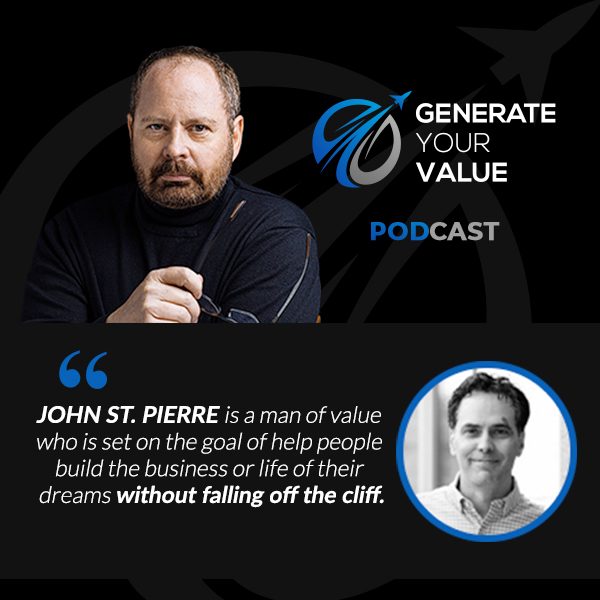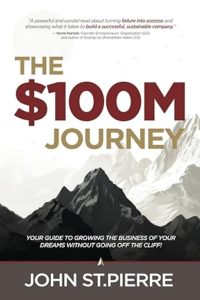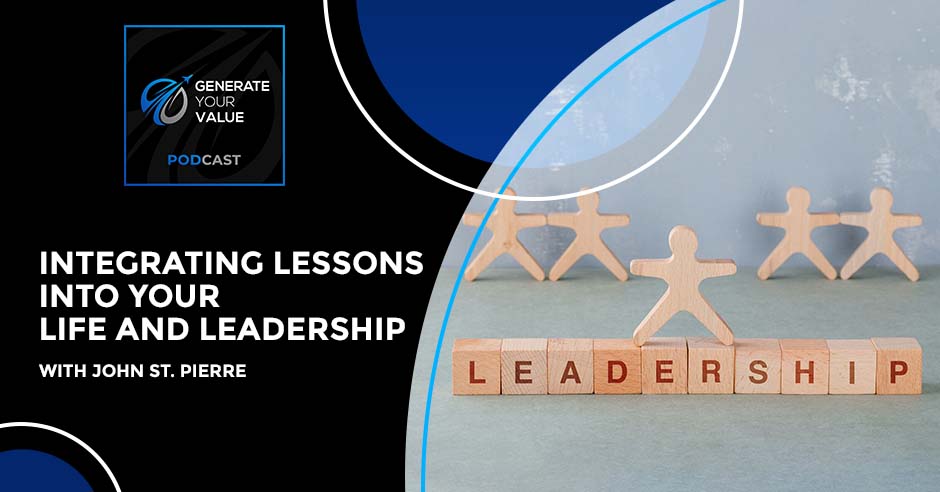Embrace failure as the ultimate professor on the road to entrepreneurial mastery. It’s not about the fall, but how high you bounce back and align your purpose with your pursuit. In this episode, we have John St. Pierre share his entrepreneurial rollercoaster. Drawing from his book, “A Hundred Million Dollar Journey: Your Guide to Growing the Business of Your Dreams Without Driving it off the Cliff,” John shares how he went from a staggering $50 million setback to a remarkable bounce back and surpassing the $100 million mark. John shares his transition from a ‘doer’ mentality to a ‘be-er,’ igniting introspection and aligning his life’s purpose with his entrepreneurial aspirations. Through his failures, he learned how to embrace vulnerability and harvest crucial principles for entrepreneurs. Tune in now!
—
Listen to the podcast here
Integrating Lessons Into Your Life And Leadership With John St. Pierre
Unfortunately, my partner in crime, Zach Levy, won’t be joining us in this episode, but I think you’re going to get a big kick out of this conversation. I’m bringing in a guest who I had the great pleasure of being on his podcast with his co-host, Rich Hoffman, Entrepreneurs United Podcast. It was such a great conversation that when we stopped and got into the green room, I’m like, “You got to come on to mine to continue this conversation.” I’m looking forward to the conversation. My guest is John St. Pierre. He came out with a new book, so we’re going to talk about that a little bit. Let me read his bio, then we’ll bring in John for the conversation.
John St. Pierre is an accomplished entrepreneur with an incredible depth of experience from both significant failures and successes. John has cofounded and lead two companies he built and scaled to over $50 billion in global revenues. One of which he lost dramatically, which we’ll talk a little bit about, while the other grew to $100 million-plus by implementing his entrepreneurial learnings from the failure the first go-round. Empowering others on the Entrepreneurs United Podcast, which I mentioned with his co-host, Rich Hoffman, John is a trusted investor, speaker, and mentor to many entrepreneurs in the business world.
John, great to see you again. Thanks for coming onto my show so we can continue the great conversation that you, Rich, and I had earlier. As I was telling you in the green room, I love stories and storytelling. It’s a great effective tool in leadership. I always like to start off the conversations with a story. Can you tell your life story and how you got into entrepreneurship for our audience?
Thanks for having me. As a kid growing up, my first experience of tasting entrepreneurism was chocolate bar sales for fundraising. My school was trying to raise some money and you had to go sell chocolate bars. We’d go start knocking on my neighbor, and the neighbors knew me, so, “Here you little Johnny, I’ll buy a chocolate bar from you.” That works well, but as I started getting further away from my home, the chocolate bar sales got harder because people didn’t know who I was. I was this kid knocking on the door.
One day, my best friend and I, Steve, had an epiphany. The epiphany was my father was a professor at the Royal Military College and they had all these cadets in dorms. He would go grade some assignments at night. One night, I was like, “Why don’t we go with him? We’ll get through the securities. We’re with my dad, he’s a professor, and we’ll run through the dorms and go sell chocolate bars.” We went there with 1 or 2 boxes each, and within ten minutes, we were sold out. We would go knock on one door and there’d be two cadets in the room, and they’d be like, “Chocolate?” They don’t get access to that kind of stuff there. We’d go a few more steps and knock on another door.

The next day, we showed up at school and we’re like, “Give us some more boxes.” Steve and I ended up winning the chocolate bar sales fundraising competition at our school. It triggered like, “What else can we do?” I learned this early concept of supply and demand with the chocolate bars with the cadets. I started doing landscaping jobs, painting jobs, and any odds and ends. We started dreaming big about what we could do in this world of business.
This was in Montreal. I was born in Canada and grew up in the South Shore, Montreal. I started living close to the border, watching all these American TV shows and glamorizing this whole idea of capitalism and what’s going on. Ultimately, it led me to come down to the United States, go to college, get an Accounting degree, and chase the American dream of building a business of value. That’s the beginning of my journey.
What do you think were some of the expectations you had at that time? Going down the United States, getting an Accounting degree, “I’m going to get into business,” and you had certain expectations, what expectations didn’t show up for you? What were some of the things that surprised you about entrepreneurship?
Right off the bat, I truly bought it hook, line, and sinker that America was a land of opportunity. You could create anything if you work at it and go hard at it. As I started having some early success when I was in college, an interesting thing happened to me. When I was in college as a Canadian student, I had an international student visa. An international student visa does not allow you to go work at the bar down the street and get paid on W-2 payroll. You don’t have a work visa, you have a student visa.
America is a land of opportunity. You can create anything if you just work at it.
My father actually forced me to take accounting classes. I was going to take general business. He’s like, “No, if you’re going down there, you got to specialize in something important.” He pushed me into accounting. My options were get a job at an accounting internship and not get paid because I could do that or go back to Canada for the summer. The first summer I went back to Northern Ontario, six hours north of civilization and went planting trees. I don’t know if you’ve ever heard about anybody going to plant trees, but it’s horrible. It’s a very horrible job. You get $0.10 a tree and you’re wearing nets for flies and everything else.
The next summer, I was like, “No, this isn’t going to work. I got to figure this out.” I saw a poster in my dorm room wall, and it said, “Own your own painting franchise with College Pro Painters.” I’m like, “That’s interesting.” Sure enough, what I came to find out is that international people that are here legally in the United States can own a business. You can own an LLC if you’re not going through payroll. I basically got a College Pro franchise. I became my own LLC owner at the age of 21 or so and ran my own college painting business as a college student.
I didn’t know how to paint, that was a different story, but College Pro trained college students on how to run these businesses, and that was another taste. When I got another taste of entrepreneurship, and I was like, “This is interesting. I can actually hire my college student friends to paint the houses. I can go around and do sales and marketing,” and I learned all these different aspects about business, I believe that the sky was the limit.
That’s how you got your first taste. What was it that surprised you that you weren’t expecting when you went into it? You didn’t know how to paint. “I don’t know how to paint. I don’t how to do to work or I found it to be harder than it was.” I imagine you’re juggling this with taking classes at the same time.
Yes.
You’ve got a time management issue?
Running a College Pro painting franchise in your first year is the hardest thing a student could possibly do. The ups and downs of, “My painter’s got to get paid, but the homeowner hasn’t paid me yet. Sherwin Williams wants their check. What is going on? I got to go do some more sales, get some more estimates, and create some more cashflow.” You start going through this transition curve. One of the things I talk about in the book as well is this transition curve when you start off with uninformed optimism. You’re so excited. “This is so exciting. I got my own painting business. I can hire college students.” You start coming down this curve into uninformed pessimism and valley of despair.
I found myself in that crisis of meaning at one point in my first summer where I didn’t think I was going to survive. I had payroll, I had supplier bills, and my painters wanted to get paid. It’s like the growth paradox. The only way to get out of it is go sell more paint jobs and create more estimates. By the way, that’s why you should never pay a contractor until the job is done because I kept running around trying to solve the problem. I got myself in a position where I had to drive back home to my little red Ford Escort, had my ladder rack on top, drove back home to Montreal, and had to go confront my father. It was very difficult because my father’s a pretty stern man and I had to ask him for some help. I had to ask him for $5,000 loan to bail myself out.
You should only pay a contractor once a job is done.
For the cashflow.
It was a very hard lesson. He made me sign a loan document. I thought he was going to help me out. I signed my loan document with interest and everything else. I promised I’d pay him back by the end of the summer, and that I would never, ever, ever ask him for money again. That was a hard lesson. I ultimately survived but learned a lot.
I’m sure later in the conversation with your other businesses get into capital and startup capital and those type things come into play for you in your book.
Yes, big time.
If I remember our conversation on your podcast, you started a business with some buddies in the sports business. Is that what you did after you got out of college? Did you sell the painting franchise or did you close it?
I’ll connect the dots real quick and then we can go through wherever you want to go. I ran a College Pro Painting franchise for two years. College Pro then ended up sponsoring my work visa to go work for them as a General Manager because I developed some unique skills on how to manage franchisees. I moved out to the Midwest, was a College Pro General Manager for two years hiring college students, and teaching them how to run a business. In the late ’90s, a bunch of College Pro GMs started out a dot-com company connecting contractors with homeowners. It was called HandymanOnline.com.
We got venture funded out of Silicon Valley, we’re growing the company like crazy, and then the 2000 crash happened. We ended up selling all of our assets of Handyman Online to Service Magic, or the bank did ultimately. Service Magic became HomeAdvisor.com. HomeAdvisor.com merged with Angie, that’s now Angi.com. That was our business that we lost during the crash. That was my first awakening to, “Maybe this business thing isn’t as easy as I thought” moment.
In 2003, I started a project management company staying with my contracting lane. I was like, “How do I hook up contractors with commercial projects?” I started a contracting business, and then I was still very passionate about sports and the sport ice hockey with a couple of best friends. I started a sports business for youth sports, running events, camps, and tours to Europe and such. I started these two businesses in 2003, and they both started growing. The sports business a few years later, we had grown a north of $50 million in global revenues. I was spending all of my time on that business, not on this contracting business and we brought on some private equity capital.
Seven months later, I was fired from the company that we had founded and grew and lost everything. Meanwhile, I saw the little project management company that was over here that was still chugging along and had to lick my wombs, figure out the learnings, and then took those learnings, applied it to the project management company. What I failed over here, I applied it over here. We successfully grew that company in north of $100 million the right way. All those learnings were all culminated into the lessons that I had to apply to not make the same mistakes I’d made before.
What was running through your head when you got fired? I’ve been fired a couple times in my life as well as laid off. I know it’s not a fun experience, but I’ve never had the opportunity to be fired from a company that I built.
Very painful. It was painful for a lot of reasons. This was my heart and soul. I had the logo tattooed on my forehead. My kids had all the apparel a little bit. This was my identity. It wasn’t just a company I worked for. All my best friends worked in the business. It was very painful. I put myself ultimately in a very vulnerable position by making some mistakes in terms of how to grow a business the right way versus too aggressively, too carelessly, too quickly, needing too much capital, and diluting yourself. There’s a lot of lessons that go in there, but obviously, I’ll never forget that day in the boardroom when the private equity investors said, “You’re out. We’re putting someone else in your seat.”
I was calling my wife and going, “I got let go from the very company I put everything into,” and having to come home and seeing my two boys and be like, “Now what?” It’s a very devastating moment. As we all know, there’s a silver lining of this story, but you hear a lot that failures are prerequisite for success and all this kinds of stuff. Although I believe all of that, in the moment, it’s not very fun.
Failures are a prerequisite for success.
It’s one thing to have to develop a mindset to say that your failures are your opportunities. It’s easy to say, but I can immediately go back to my own emotions when I was fired the first time. How much I was beating myself up and so forth. When you’re in the middle of those emotions, it’s very difficult. Even though your brain is saying, “Here’s an opportunity to go maybe do something that’s even better or greater.” For a while, it’s a grieving process. We all know about the grieving process of many emotions or phases that you’re going through. I’m watching my father go through that now after we lost our mom this past Thanksgiving.
Sorry to hear that.
It’s not fun to watch from that perspective. You fell off your horse, so to speak, with that particular company. What did you do to dust yourself off? Where was your head at? What kind of process did you use to pull yourself up by the bootstraps, as they say, and go over to the other company and keep going?
Before I answer, my deepest sympathies for your loss and your family.
Thanks.
I’m sure that was very tough. In the midst of the failure, it’s a little bit of what just happened. It’s a little bit of trying to be strong to my family, my wife and my kids, that I can be resilient and that big chest popping out, “No, I’m fine. I’m good.” I think at the deep root of it for me, it was two things that really guided me. One was perspective that I think we lose a lot. Two was introspection. What were my contributions to the situation as opposed to, “Look what somebody did to me?” Those two helped me a lot.
When entrepreneurs get themselves in a position where they’re stressed out about their business or things aren’t going as well as they thought they were going to be, perspective is big. It’s because you lament what’s going on in your business, but think about people who may have literally lost their business, or lost a family member, or in the hospitals dying of some disease, or even in Europe now, some of the things that are going on over there.
When you think about all of that, and you then think about your life, you’re like, “This sucks, but it’s not as bad as the way you people are experiencing things across the world. I have my health, I have my family, I have my kids.” The perspective lays a groundwork for, “Stop feeling so sorry for yourself, this isn’t the end of the world.” The introspection thing becomes more intellectual as you start thinking. I start journaling. I had never journaled, ever.
I started journaling. I’m writing down, “What is going on? What is happening in in my head? What did I do? If I had to reverse the clock, what would I have done differently?” When I married those two, perspective and introspection, I was able to advance, “Now what? Now where do I want to go? How do I generate my value?” That is a whole other conversation we can get into that connects with you. How do I generate my value to this world? Where am I going next? What am I going to do? That was it for me. Perspective and introspection.
It’s tough to be a leader when you’ve got things going on in your own life. Some of the hardest times from my time at Boeing was going through two divorces and having to stand up in front of my team and keep the business going and trying to stay focused with things when things back home are in a terrible state. That’s where your mind is. It’s where your heart is. Trying to deal with that stuff, yet for your employment, for your career, and for those things, you have to compartmentalize those things and put them off to the side and try to be in the moment with your team and deal with whatever business issues you need to deal with while that’s going on.
Very difficult. Part of my career, and I have to mention, it was the same for you. Probably filled with some self-doubt and so forth, trying to take those first steps in your other business and start integrating those lessons learned and hoping for the best that we can keep this one going and see improved results from the integration of the lessons learned.
No doubt. That goes back to that introspection part. “How am I going to take this message that’s humbling me, and what am I going to do with it?” It’s a very important thing for people to do in life. To your point, when things aren’t aligned, whatever the misalignment may be, whether it’d be a situation at home, or you’re not getting along with people at work, or your business is going exactly where you are, it’s that moment of reflection that I think is important.
People don’t take enough time to do. They just keep going. When things weren’t going well in my business, I kept selling more paint jobs. Going back to my college, for example. I’m like, “Let me go sell some more paint jobs to get myself out of this thing,” as opposed to sitting back and going, “Let me reflect. Let me journal. Let me get some deep thought into this.” I think that’s where the best stuff happens.

Talk a little bit about the mindset piece because what I heard you say, and I think this is where people get into trouble with these events and transitions, per se, is the mindset. I’ve had something bad happen to me. Is my focus and my mindset going to be outside of myself? What is the world doing that’s screwing me over? Is it internally focused in saying, “What part of what happened am I going to own and be introspective and work on myself that are in my control? What things were out of my control and I’m going to let them wash away?” How big of an impact was that mindset for you, do you think, in that journey?
It was massive. It came from the earlier learnings as a College Pro franchisee. You can only control what you can control, whether it be sports or business. You can’t control the referee’s call. You can only control your reaction to it and how you’re going to move forward with it. There are a lot, as you know, unfortunately, people who externalize the problems. “It’s not me, it’s them. It’s not me, it’s this situation.” I think the reality is, as an entrepreneur, what I learned early on is if I want to grow and I want to develop, I always got to put the mirror back up at me because as the CEO of a business or a coach of a team or general manager of a team, at the end of the day, all decisions point back to something you should have done differently or did the right way.
In my scenario, although I was not happy with what took place from an emotional perspective and there were some things that happened that I didn’t think were right from a moral perspective or a principle perspective, I couldn’t control it. That’s what happened. The only thing I could control to advance myself in my life were the factors that I contributed to. That deep thought of, “What would I have done differently? How can I, versus externalizing the situation, introspectively look at things is the only way to advance in life?” Regardless of the situation you’re in, whether you’re an entrepreneur or not in life, it’s the only way to do things in order to take that next step.
When I go back to that transition learning curve that I talked about, when you’re in that valley of despair of, “What do I need to do?” You’re trying to get back up the curve to informed optimism. The only way to get there is to digest the learnings and have a lot of clarity on what you’re going to do about it. There’s an acronym in CTFAR that we use. When there’s a Circumstance, which is the C, it creates Thoughts, those thoughts create Feelings, the feelings create Actions, and the actions create your Results. If the circumstance happens, “I got to let go from this company I built for 15 years over $15 million,” pretty big circumstance, but it’s factual. That’s an undisputed fact. That is what happened.
I then have thoughts about it. The thoughts are, “This sucks. I wish this didn’t happen.” Whatever those are lead to feelings. The feelings is where it gets tricky because the feelings could be, “I can’t believe this happened to me. I’m going to go into my shell.” That, or it’s, “What did I learn from this? What’s going on?” Those feelings start changing the actions you’re not going to take. If you take the appropriate actions, you’ll get better results and you’ll move up the curve. If you take the wrong actions, you’ll get worse results and you start heading back down further into that crisis of meaning and value of despair area. That CTFAR acronym worked for me in that instance. It was digesting my thoughts, my feelings, and my actions, which will lead to my results.
I listened to the episode that you and Rich did about your book and your journey. What I took away from it was something that I coach a lot with my clients is I use a model called be-do-have. When I was listening to your words about your journey, going from the $50 million firing over to the $100-plus million growth is that, correct me if I’m wrong, you went on this journey of you are always do, do, do piece, and then you went into this introspection in that transformation and started working on the be to get that alignment of, “What’s my mission? What’s my purpose and my why in life? How did I get myself here?”
I know this because I went through it myself from the divorces. I was in the middle of a bad second marriage. I sat there. We may have talked about this when I was a guest in your podcast, but I shut the door and like, “This is not the life I want for myself. What the heck do I need to do to get myself into a better place in life?” That started my journey out of the do and into the be, from that perspective. That’s the same kind of thing I heard in your discussion with Rich on that episode. You sat down and was introspective after that.
I hate to use the word failure because it wasn’t a failure. It was a bump in the road because of the way that you approached it that you did a lot of self-discovery in that saying, “I need to kind of align what I’m doing here with who I truly am in the world. Would that be a fair takeaway for myself from your episode with Rich on that in your journey?”
First off, I would call it a failure, personally. I appreciate the roadblock, but it was a failure and I’m not afraid to say that, I think it just was. It’s through those failures that you learn and through those challenges that you learn. A wise man once shared this quote with me from Albert Einstein, “Rather be a man of success, be a man of value.”

That’s where my company name came from. It’s my favorite quote in the whole world.
Exactly. You’re the wise man who shared that quote with me.
It’s my mantra.
You shared that quote on our podcast. I had never heard that quote before, by the way, until you shared it. That’s what I went through. In the moment of this failure, I took some time, I started thinking, and I started journaling as I mentioned before. One of the things I discovered was, why was I trying to grow this sports company to $100 million? That was our vision, by the way. When we were at $10 million with the sports company, I said, “We are going to $100 million in 5 years. Let’s go.”
“This is what we’re going to do.”
We’re going to go to $100 million in 5 years. It got everybody excited. There was a few people going, “How are we going to do that, John?” I don’t know. Let’s go. We got halfway there when this situation happened. It felt like we were heading in the right direction. The question is why. Why were we going to $100 million? What was I trying to accomplish? For me, I had this vision of I want to grow something big and successful, but why was I doing it?
Put it from the perspective as an entrepreneur. Think about this for a second. As I was growing the business and bringing on more and more capital, my equity was going down, so I was owning less of this thing that I was growing. In this moment of failure and self-reflection, and what is going on, I had always heard from mentors and people a few years older than me who mentored me, “At some point, you’re going to figure out what your purpose is.” I’m like, “Yes, I know what my purpose is. My purpose is to grow businesses. Let’s go.”
To be successful with what how you define success at that moment in your life.
Exactly. I couldn’t understand what they were talking about. I was like, “I know what my purpose is. My purpose is to grow this business and have fun with my family.” I couldn’t figure it out. What I discovered was that, what I was trying to grow in this business was completely disconnected. What I wanted my life. I was trying to create wealth and freedom. You don’t create wealth and freedom through growing a business you own less and less and less of, and lose control over and loss. That’s not the way it works. I couldn’t connect those dots.

During this moment of self-reflection and deep thought, the question was, “What’s my purpose beyond me? What am I trying to do here?” Ultimately, in life, what am I trying to do? Forget about entrepreneurship. In life, what is my true north lifeline? What do I want in the next 30 years of my life? Let me back that back to, “What do I need to have for a business? Do I need $100 million business that I own 5% of? Do I need a smaller business that I own more of? What do I need to accomplish my true north life plan?” For the first time, I identified what I wanted in my life and all these different segments of my life. Not just business, but family, health, spirituality, relationships, medical, and everything. I then aligned it with my business plan. For the first time, my life plan and my business plans were aligned.
Could you even say they were in some ways overlapped?
Yes, 100%.
That’s my mission with my business is to get people to understand how much life and business overlaps. They have to. In a way, everything overlaps. Your health overlaps to your business from the way that you go after a business and run it, but also, even from a construct basis, there’s a ton of overlap between business and life. I don’t think a lot of people realize or don’t take the time to think about it.
That’s exactly my point. I was running for the sake of running. I was growing for the sake of growing. It had no connection. I was fulfilled in my life because I was growing something, but it didn’t connect with my goals in life. Once I aligned those two, it’s like, “I can’t believe this.” How many entrepreneurs, to your point, keep running and running? They get caught in this growth paradox, and then they’re working 80 hours a week. They’re stressed out. They’re not spending enough time with their family. Their relationships are getting sour. They’re not seeing their friends enough. They’re health goes to crap. They then wake up one day like, “What happened? Is this what I want in life?” It’s huge thing for me.
With your experience in business now, what would you say is the importance of a why to your life and to your business, and the alignment between the two?
It’s everything, Simon Sinek’s Start With Why. Think about this, I used to sit down with our executive teams around Q4 of every year for our strategic business planning session. I would play Simon Sinek’s Start With Why video that’s on YouTube, it’s got millions of views. It’s not how you do it or what you do, it’s why you do it. What’s our why as a business? We come up with our strategic plan for our business, and it’ll all be laid out, what we’re going to do in the next ten years and everything else. I never did that for myself. I did it for my business, never for myself. That’s totally disconnected. You got to know what you want for yourself first before you design your strategic business plan because they need to connect.
I call it the oak tree. When things are going up and down in the business, you need that why and that purpose as an oak tree to hang on to while you’re going through the ups and downs and valleys of the business with some things that are in your control and some things that are out of your control.
That’s right.
Let’s talk a little bit about the book. The name of the book is The $100M Journey: Your Guide to Growing the Business of Your Dreams without Going off the Cliff. Let’s talk about the why, how, and what of it, as somebody’s in the middle of the process. I’m editing my book at the moment. I’m curious about your experience. Let’s start with the why. Why the book? In general, why of the book and why now?
It connects back to my why, ultimately. It’s our full discussion, and I’m holding here The $100M Journey. It just came out on Amazon. This is the why. When I started reflecting on what is my purpose beyond myself, yes, I have some goals for myself and what I want to achieve, but ultimately, what drives me and what’s my passion? Jim Collins has this hedgehog concept of what success looks like. What are you most passionate about? What can you be the best in the world at? What can drive your economic engine? When you live in the intersection of those three circles of the Venn diagram, that’s where success lives. For me, I’ve always loved entrepreneurship. I always loved working with entrepreneurs. I always loved coaching entrepreneurs and helping them achieve their goals.

I had a little bit of a situation here. I had a massive failure. I had to get those learnings from it. Not only get the learnings, but then apply it to a business and make that business drive, succeed, and get it to where it needed to be to prove that these are principles are correct. In doing so, as that project management company started achieving the success that the principles were helping it execute, I said, “I got to get this message out. I want to help entrepreneurs never make the same mistakes that I’ve made and connect with them on these principles.”
It’s almost a “do this, not that” book because if you don’t apply these seven principles of entrepreneurial success, you will potentially put yourself in a position to experience a massive failure like I did. If you do, you can protect yourself and build a business the right way. The mission of this book is to help entrepreneurs see themselves in my story and connect with some of these principles and go, “We got to make a correction here because we’re heading down the wrong path.” My mission now in life is to help others achieve their dreams without falling off the cliff and without creating these fatal mistakes that we control to a large degree.
I was chuckling to myself when you were talking about this piece in your conversation with Rich, because I’ve joked with some folks. How much I wish my two kids had USB ports in their head where I could take all of my failures and all of my experiences, plug it into their USB port and download all that information.
The logical side of it, the emotional side of it, and the spiritual side of it, so that they wouldn’t have to go through the same pains and experiences that I went through in hopes that they get to a state of joy, happiness, and success, a lot quicker than I did for myself. How do you feel about that? How important is it for experience for people? It’s one thing for you to sit down and want to help people to generate value in the world by writing this book. It’s going to help folks. What is the power of experience for human beings?
I think it’s necessary. It’s a component of life. The example you gave about your kids and putting a USB port in the back of their heads. It’s a great idea. The reality is, if we were able to do that, if we role play that for a minute, they probably wouldn’t make the mistakes we made potentially, but they’d make others. The reality is, that’s life and life is full of those obstacles and challenges. That’s the simulation we’re in. It’s like, “How do you overcome this game to get to the next game or the next level?” When you put it in a gaming perspective, the reality is we live in this life that has these challenges and they’re meant to be there.
Versus, there’s a lot of talk now about everybody gets a medal. Are you working for it? You’re overcoming these adversity and challenges. What’s the importance of that? What’s the importance of overcoming adversity and challenges, especially when you’re young, so that you can learn how to overcome them when you get a little bit older and help others through it. To me that’s a life lesson that makes life more enjoyable. Now that you say that, and then people are stressed out to the max, they’re unhealthy, and they’re not doing well with situations, I get it. As you experience these challenges and you overcome them, you’re feeling that, “If I can do this, I can do anything. I can overcome any situation.” It’s so powerful.
This book gets to the heart of the matter between the different people asking me, “What’s the difference between consulting and coaching?” Consulting tends to lean towards, “I’m going to come in, look around, and provide you some answers.” It’s kind of a blueprint. Whereas coaching, you’re sharing your experiences and your thoughts. This book is a way to, in essence, help coach somebody without you being physically in the room or on a Zoom call with this person. It’s to say, “I’m going to plant some ideas in your head. I’m going to share to you how I came to develop these seeds of thought through my own experiences. I’m going to share those experiences with you.” The reality is, you’ve got to take this info in this book and integrate it or apply it to your own situation and to your own life.
That’s the work you have to do. This is not giving you a blueprint. This is not, “Go do step one, go do step two, go do step three exactly as I state here.” It’s more of, “Here’s an idea based off of my experiences. Think about it and how would you apply it to your situation, to your life, to your why, and so forth. Run with it and see where it takes you. Go have that experience. We’re not going to eliminate that experience for you. We’re hopefully going to make it a more robust experience for you by planning some ideas in your head.”
As you look through what you said there, in life, I’ve read business books that probably told me not to do some of the things that I did. By reading a book doesn’t mean you’re obviously going to overcome all these obstacles and not run into any situations. The reality is, some people may read the book and not connect with some of the messages. It takes one person to connect with one of the messages at the right time, from the right person to change someone’s life and help them overcome a challenge that they’re facing or help them build the business of their dreams or help them not fall off the cliff. That’s ultimately what I’m trying to achieve here.
Let’s talk about the how. How was the experience of writing the book for you? I know the answer because I listened to you and Rich talk about it. For our audience, how was that experience for you?
I had dreamed years ago about writing a book. Rich and I talked about writing a book many years ago together. It almost was a distant, “I’m not sure if I can do it” perspective. I then started thinking about writing a book years ago, maybe 5 to 6 years ago. I was like, “What would I write about? Who wants to hear? What do I have to say?” It was in my mind. “Do I have a good story and a good message?” All of a sudden, this big story happens that I think is pretty compelling. It’s an entrepreneurial failure with learnings and lessons that are true and hardcore, and then principles that were applied to create a tremendous amount of wealth and value in a business the right way.
The story developed itself for me where I had to tell it. How can you not tell the story? It was very difficult. The process of being vulnerable to open your chest to the world and go, “Here’s exactly what happened. Here’s where I messed up. Here’s what I would do differently.” The humbling part of that is a very big mode of vulnerability. I wasn’t somebody who was always very vulnerable, so that was a different aspect of myself I had to bring out to the world. Crystallizing these in a book that you don’t want it to be too businessy and boring, but you also need to pass through some good learnings.
It was quite a challenge. I had a great publisher that worked with me, Kira Britton. At the end of it, you’ll see when you’re done writing your book. When you open that box and you see the book for the first time, the feeling you have of, “You know what, if I can do this, I can do anything” kind of approach. Like somebody who runs a marathon. My co-host, Rich, ran a triathlon. Never in a million years would I thought Rich Hoffman would run a triathlon, but he did it. His mind is like, “I can do anything.” When you set your mind to something, you’re able to achieve it. That’s what writing the book did for me. He was giving more confidence that there is a good message here and it is a good process.
Who would you say the book is for? Who’s your target audience?
I’m not going to say all entrepreneurs. I think all entrepreneurs may enjoy the story, but who it’s specifically targeted for are entrepreneurs that have maybe running their business 5 to 10 plus years. Their business is between $5 million and $20 million of revenue. They’ve established a nice lifestyle business. They aspire to build a high-performance business. A business they don’t have to be there and run it every day. A business that continues to generate passive income for them or create a good amount of wealth for them on an exit or something of that nature.
The road between a lifestyle business and a high-performance business is rocky. That’s where the messy middle is. That’s where the growth paradox all comes in. That’s where cash becomes king. It’s a very difficult spot. If you’re trying to aspire to do that and bring on investors and diluting yourself, there’s a whole bunch of other things in there that can be dangerous, that’s who the book is for.
Start diving into the scaling issues to be able to get that revenue high enough to make it more than a lifestyle. It’s always one of the rockiest parts of growing the business. You’ve got to dive into the processes. How is it that we can duplicate things over and over again to bring them more revenue without having to invest on a ton of capital?
Our time is coming to a close. Unfortunately, I could feel like you’re a kindred spirit. We could sit here and talk for hours. What’s the best way that A) Somebody can find your book, but also B) Connect with you for any reason, whether it’s for coaching, mentoring, or potential partnering in a business, or being a client in your business, or anything of that nature? What’s the best way they can reach out?
Along with the book, we have a new website that came out, it’s 100MJourney.com. You can connect with me on social links on that, or on social directly at @JohnStPierre100. The book is on Amazon as well. I provide free consultations with anybody who would love to chat about their business. Back to the mission, any entrepreneur who wants to talk at any time, I’m available and would love to chat with them. I appreciate the opportunity to speak again. You’re right, we could probably talk for a very long time. This is a great conversation.
One last question. It’s a question we ask every guest who comes on our show because we like to see the thread, we like to see where the golden thread is between all the answers. It’s a question I personally had to be very introspective about when I decided to name my business what it is. What do the words Generate Your Value mean to you?
To me, one of the parts that happens too when you write a book is you start thinking about the title of your book and the subtitle of your book. You go through it 100 million times.
Ultimately, in the middle of that.
The subtitle of my book is the answer and I connected with it, which is I want to help entrepreneurs and people build the life or business of their dreams without making some of the catastrophic mistakes that I’ve made or that others have made before them, and help guide them in a way. It’s because there is a roadmap. We just don’t always know what it is, but you can develop a roadmap if you have the right guidance and coaching and words of wisdom with you. That’s my goal. Help people build the business or life of their dreams without falling off the cliff.
For the audience, I hope that you are taking lots of notes and we’re gleaming some of our conversation. I feel like John is a living example of a lot of the stuff that we talk about on this show in terms of self-leadership and leadership. How important the mindset is to say that you fell off your horse, you need to get back up. To be introspective and look internal instead of external and say, “What was in my control? What can I learn from this? What can I integrate those lessons to and keep going?”
To a certain extent, I think, John, you’re a little bit of a poster child. I hate to use that term, but a poster child for what we talk about on this show and why when you reached out, I said, “Let’s get going on an episode here.” I’m like, “Yes, let’s go.” That was one of the things I took away from my conversation with you and Rich on the Entrepreneurs United Podcast, which I highly recommend. Go listen to the podcast. There are great guests, great conversations, and a lot of great information that’s out there.
I can’t thank you enough, the audience, for taking that valuable resource that’s limited for all of us called time to be able to spend it with us on this episode. I hope you got a lot of John McCallum Golden Nuggets on the show of information that you could take away and improve your life somehow, whether it’d be personal life, business life, career, or anything about generating value in this world. With that being said, have a great day, have a great week, and we’ll see you here next time. Take care.
Important Links
- Entrepreneurs United Podcast – Apple Podcasts
- Start With Why
- The $100M Journey: Your Guide to Growing the Business of Your Dreams without Going off the Cliff
- @JohnStPierre100 – Twitter
About John St. Pierre
 John St Pierre is an accomplished entrepreneur with an incredible depth of experience from both significant failures and successes. John has co-founded and led two companies he built and scaled to over $50M+ in global revenues. One of which he lost dramatically, while the other grew to $100M+ by implementing his entrepreneurial learnings. Empowering others on the Entrepreneurs United podcast, John is a trusted investor, speaker, and mentor to many entrepreneurs in the business world today.
John St Pierre is an accomplished entrepreneur with an incredible depth of experience from both significant failures and successes. John has co-founded and led two companies he built and scaled to over $50M+ in global revenues. One of which he lost dramatically, while the other grew to $100M+ by implementing his entrepreneurial learnings. Empowering others on the Entrepreneurs United podcast, John is a trusted investor, speaker, and mentor to many entrepreneurs in the business world today.







